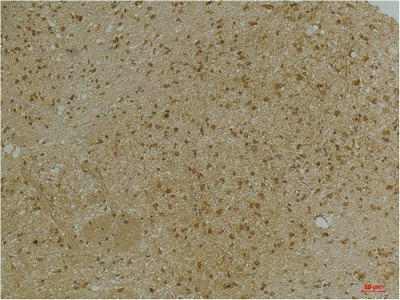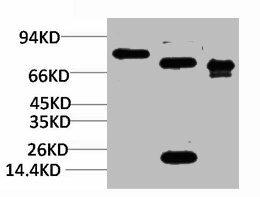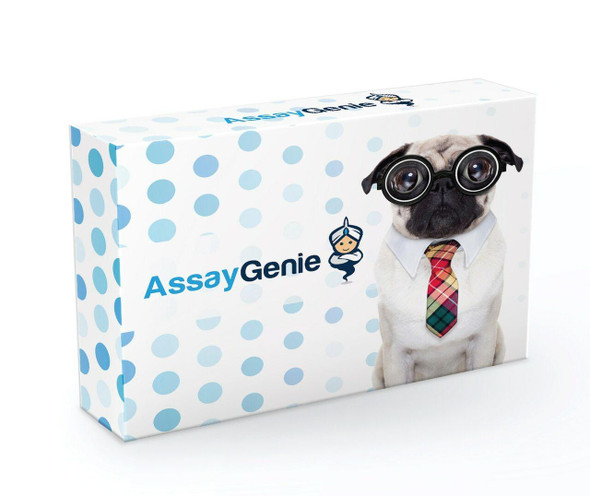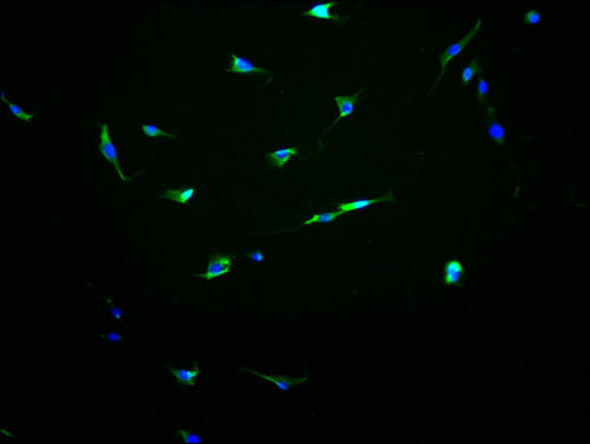Description
| Antibody Name: | KCNN2 Antibody (PACO07185) |
| Antibody SKU: | PACO07185 |
| Size: | 50ug |
| Host Species: | Rabbit |
| Tested Applications: | ELISA, WB, IHC |
| Recommended Dilutions: | ELISA:1:2000-1:10000, WB:1:1000-1:2000, IHC-p:1:100-1:200 |
| Species Reactivity: | Human, Mouse, Rat |
| Immunogen: | Synthetic Peptide |
| Form: | Liquid |
| Storage Buffer: | Liquid in PBS containing 50% glycerol, 0.5% BSA and 0.02% sodium azide. |
| Purification Method: | The antibody was affinity-purified from rabbit antiserum by affinity-chromatography using specific immunogen. |
| Clonality: | Polyclonal |
| Isotype: | IgG |
| Conjugate: | Non-conjugated |
 | Immunohistochemical analysis of paraffin-embedded Human BrainTissue using KCNN2(SK2) Rabbit pAb diluted at 1:200. |
 | Immunohistochemical analysis of paraffin-embedded Mouse BrainTissue using KCNN2(SK2) Rabbit pAb diluted at 1:200. |
 | Western blot analysis of 1) Rat BrainTissue, 2)Mouse Brain Tissue, 3) HepG2 with KCNN2(SK2) Rabbit pAb diluted at 1:2,000. |
| UniProt Protein Function: | KCNN2: Forms a voltage-independent potassium channel activated by intracellular calcium. Activation is followed by membrane hyperpolarization. Thought to regulate neuronal excitability by contributing to the slow component of synaptic afterhyperpolarization. The channel is blocked by apamin. Belongs to the potassium channel KCNN family. KCa2.2/KCNN2 subfamily.Protein type: Membrane protein, integral; Channel, potassium; Membrane protein, multi-passChromosomal Location of Human Ortholog: 5q22.3Cellular Component: cell soma; cell surface; dendritic spine; integral to membrane; plasma membrane; smooth endoplasmic reticulum; T-tubule; Z discMolecular Function: alpha-actinin binding; calcium-activated potassium channel activity; calmodulin binding; protein domain specific binding; protein homodimerization activity; small conductance calcium-activated potassium channel activityBiological Process: potassium ion transport |
| UniProt Protein Details: | |
| NCBI Summary: | Action potentials in vertebrate neurons are followed by an afterhyperpolarization (AHP) that may persist for several seconds and may have profound consequences for the firing pattern of the neuron. Each component of the AHP is kinetically distinct and is mediated by different calcium-activated potassium channels. The protein encoded by this gene is activated before membrane hyperpolarization and is thought to regulate neuronal excitability by contributing to the slow component of synaptic AHP. This gene is a member of the KCNN family of potassium channel genes. The encoded protein is an integral membrane protein that forms a voltage-independent calcium-activated channel with three other calmodulin-binding subunits. Alternate splicing of this gene results in multiple transcript variants. [provided by RefSeq, May 2013] |
| UniProt Code: | Q6PJI0 |
| NCBI GenInfo Identifier: | 25777645 |
| NCBI Gene ID: | 3781 |
| NCBI Accession: | NP_067627.2 |
| UniProt Secondary Accession: | Q6PJI0,Q0VFZ4, Q6PJI0, Q6X2Y2, A6NF94 |
| UniProt Related Accession: | Q6PJI0,Q9H2S1 |
| Molecular Weight: | 26,341 Da |
| NCBI Full Name: | small conductance calcium-activated potassium channel protein 2 isoform a |
| NCBI Synonym Full Names: | potassium calcium-activated channel subfamily N member 2 |
| NCBI Official Symbol: | KCNN2 |
| NCBI Official Synonym Symbols: | SK2; hSK2; SKCA2; KCa2.2; SKCa 2 |
| NCBI Protein Information: | small conductance calcium-activated potassium channel protein 2 |
| UniProt Protein Name: | Small conductance calcium-activated potassium channel protein 2 |
| UniProt Synonym Protein Names: | KCa2.2 |
| Protein Family: | Small conductance calcium-activated potassium channel protein |
| UniProt Gene Name: | KCNN2 |
| UniProt Entry Name: | KCNN2_HUMAN |






